
> > Full Disclosure
Łomża on my mind
Flashback: September, 2002. After a grueling journey from Dulles International Airport to Warsaw Okecie, I am picked up and driven to my new hometown by a future student. I am tired but naturally interested in seeing what the town looked like.
I already knew a few very basic facts about the city. I had a sense of its size (around 60,000 people) and knew from some websearching that it had had a large pre-war Jewish population. It was mostly left out of the guidebooks to Poland, though it occasionally merited a few paragraphs mentioning its architecture, church, and cemeteries.
I had found it on a map:

And I knew how to pronounce it. (The Ł is pronounced like a W in English; the ż is pronounced something like the s in treasure; put it together and it’s kind of like “Womzha”.)
After about two hours we reach Łomża and I get to look around. My drivers point out a few features (“There’s our McDonald’s, here’s the bus station”). I didn’t have any way to compare it to anywhere else in Poland, but I noticed a few things – the Nike store, the adidas store. My first glimpse of Łomża hinted that it was small but not completely isolated from the rest of the world.
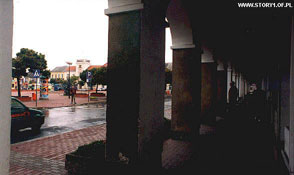
View of the market square. Uncredited photo from lomzaxxxl.republika.pl.
Over the next few days, I explore the city a little bit. There isn’t really too much to see. There is one major street with shops and bars, a market square with more shops, some nice churches and some interesting old apartment buildings. Most of the city was destroyed in WWII and even those buildings which survived the war are run-down, damaged, abandoned, and sad. A couple of parks liven things up a bit, and in the chilly fall it is fairly lively during the daytime and evenings, with kids running around and young people hanging out on the streets.
I am uncertain about what life in such a small community will be like, let alone one where nobody speaks English (or German either). Still, it seems pleasant enough. I am cautiously optimistic about living here.
![]()
Now (February 2004): Today, it’s hard to believe that I’ve lived for so long in such a town. I have some genuine affection for Łomża, but it is just too small for my tastes.
The only other cities I’ve lived in for very long are Frostburg, Maryland, and Washington, DC. And compared to Łomża, Frostburg seems like a massive and modern metropolis. It’s an interesting comparison to make; after all, Łomża is eight or more times larger in population than Frostburg. But Poland is a poor country and has different traditions, whereas Frostburg is pretty much a typical small college town with typical American culture. In Poland, people never used to go out to restaurants or bars, didn’t use to have anything in the shops worth buying, so they lived on their own and stayed at home, entertaining their friends, cooking elaborate meals, drinking vodka, making their own clothes. Today this is changing for young Poles, especially in the big cities, but it is still pretty much the norm in a small and economically struggling place like Łomża. For a foreigner with no family and no roots, there is not a whole lot to do. But like Frostburg, there are many things to like about a small Polish town. Here are a few of my thoughts on interesting or positive aspects of Łomża:
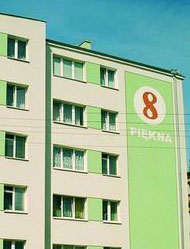
Photo from lomza.info, uncredited. This is the view from one of my windows.
- The Architecture. Basically, the buildings of Łomża can be divided into two categories: communist apartment blocks and crumbling pre-war buildings. It’s hard to defend the former, at least from an aesthetic point of view, but they have a few charming features, including their colorful decorations. These are the same all over Poland, but they look nice, with stripes and circles and giant numbers painted on the sides. We’d never have anything like that in America. The older buildings are, I think, really cool. These were not gorgeous buildings sixty years ago, and now some of them are in terrible condition, but I think they create an interesting atmosphere. For one thing, you see the damaged old buildings and start to think, probably they’re still damaged from the war, and it helps to bring home the fact that this whole region was absolutely devastated by World War II. But there is also something just romantic about the crumbling old facades and battered ruins. It makes you think that this is a poor country, but nonetheless, people manage to live and survive. It’s tragic but ennobling at the same time.
- The River. The river that runs alongside Łomża is called the Narew (pronounced like Nah-rev). It is not the most impressive river ever, but it is a sure-enough river and it looks really nice in the summer. It is nice to be a ten-minute walk away from a river at all times — and it’s the kind of sleepy, half-isolated river where I imagine kids would go to fish after skipping school on a warm spring day. I even have a business plan for some local kid: to build a raft and ferry people across the river during the summer, since bridges are few and far between. It seems like a good way to spend your summer.

Photo by Gabor Lorinczy. Full version of photo available at 4lomza.pl.
- Country livin’. This is hard to explain. Again, I will have to compare to living in Frostburg (DC doesn’t really enter the equation anywhere). Poland is still a very agricultural country, filled with small farms. This is something that has disappeared in the U.S. and western Europe. But practically everybody in Łomża is tied pretty closely to farms and farming. Some of my students have cows and pigs; I can walk a few blocks from my apartment and count the chickens in people’s yards; I see horses pulling carts on the streets and have watched a farmer plowing his little field with a horse and a hand-guided plow. Even those people here who are purely “city folk” are mostly just one generation removed from the farm. And we are talking about small farms: one or two cows, a couple of hogs. It is really interesting, and I’m glad to have witnessed it because everyone knows it is going to disappear in the future as big western farming corporations take over and restructure the agricultural economy of Poland (perhaps the biggest drawback to Poland joining the EU).
It is quite a bit different from living in western Maryland, where people listened to country music and thought of themselves as country-folk, but generally didn’t live too differently from anyone else in America. In Frostburg, I’d go to the supermarket and buy the same food as anyone in the whole country; in Łomża, I go to the small corner grocery store and buy bread that was baked that morning, eggs that came from a farm nearby, local cheese (the Narew region supposedly has some of the best cheese in Poland), local potatoes, and if I were a meat-eater, local pork/sausage/chicken. People in Poland seem much more likely than Americans to make their own wine from their own grapes, or make their own vodka from god-knows-what. It feels like a step into the past, when things were not so commercialized and integrated and modernized, and it’s a really pleasant change of pace.
![]()
Łomża is not much of a tourist draw, but I will mention some of the main attractions and show a few pictures. The photos are taken from various internet pages without permission, but I’m trying my best to cite them and hope nobody will mind too much.
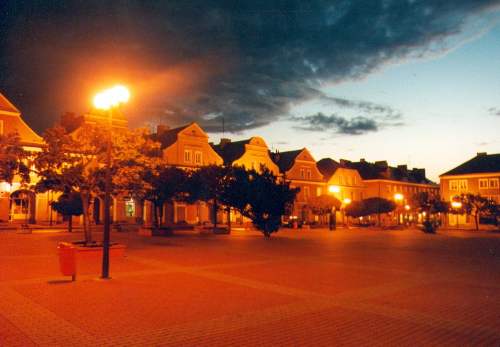
Market square photo from Łomża official page, uncredited.
- The Market Square. This is okay. It gets sort of lively in the summer, when some of the cafés set up in the square itself. This is where the city hall is, and a sort of indoor market hall, and some shops and a few bars. Nothing fancy. There is no market here anymore — they set that up at a more convenient location. At Christmas time they decorate one of the trees in the middle with lights to make a rather sad-looking Christmas tree. I live about five minutes’ walk from here.
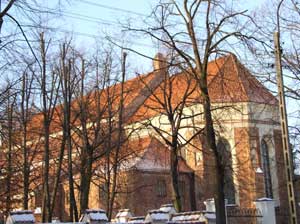
Katedra photo from Łomża official page, uncredited.
- Churches. The main church of Łomża is referred to as the Katedra which seems to imply that it’s a cathedral, but I don’t think I could call it that. Still, it’s a big church and quite old — parts of it date to the fifteenth century. My main memories of being inside here are that it is always freezing cold because they don’t heat the churches. And you have to kneel on the cold floor. There a bunch of other churches in Łomża as well, most of them less interesting. They’re all Catholic of course. There are more pictures of the churches on the Łomża official site. The city had a huge Jewish population before the war (55% I’ve read), and I’ve seen pictures of a Great Synagogue, but it was destroyed during the German occupation.
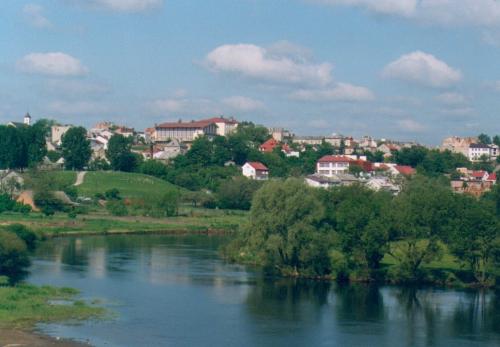
Narew photo from Łomża official page, uncredited.
- The Narew. I mentioned this above as one of the nice things about the city. Supposedly if you go further upriver, the Narew is amazingly clean. It also turns into a bunch of snaky rivulets and marshes. I want to go up that way and do some canoeing or kayaking in the spring.
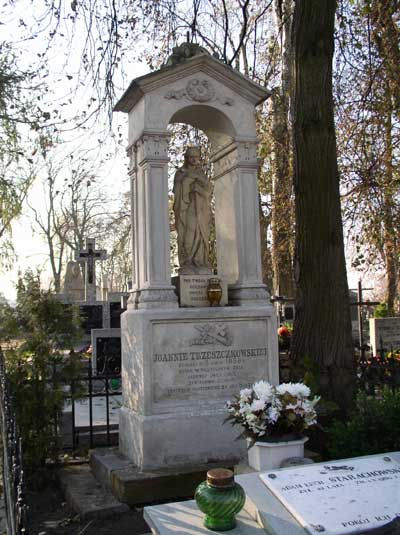
Cemetery photo from Łomża official page, uncredited.
- The Catholic Cemetery. This is interesting in many ways. Different cultures have different kinds of cemeteries. In Poland, they are usually enclosed in walls, with closely-packed graves and little walkways, a few trees, no grass. Instead of flowers, Poles put candles on their loved ones’ graves. On All Saints’ Day (November 1), everyone goes to the cemeteries (like Memorial Day in the U.S.) and puts candles on graves. During the nights in early November, the cemeteries have a strange beauty with all the candles burning.
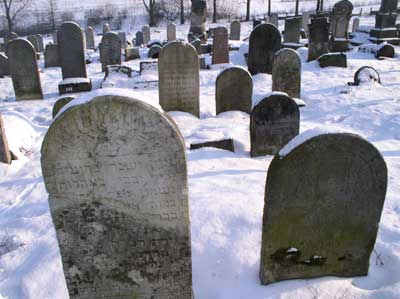
Jewish cemetery photo from Łomża official page, uncredited.
- Jewish cemeteries. I have to admit, I never had a very strong interest in Jewish history and culture before coming here. I mean, it was interesting, but no more so than any other culture. But it is definitely an important topic in Poland. Łomża used to be half-Jewish until the war, when the Jews were either killed right here or in nearby towns or eventually shipped out to concentration camps. It is eerie to think about. The Jewish cemeteries in Łomża apparently were wrecked during the war, languished for years and years under the communist governments, and have been somewhat restored in recent years. There is a little information (and more pictures) at this Łomża Jewish Cemetery website (it’s in English). I have visited the cemeteries and think they are interesting — really the only thing around town that shows that this used to be a Jewish city. They are not in great shape but they seem to be as well-maintained as possible, considering there is no Jewish community here to keep them in good condition and they are not in use.
![]()
Of course, there is really only one important thing to visit in Łomża: me. Here is a picture of my apartment building:
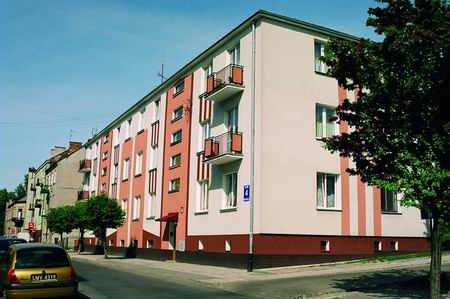
This must be a pretty old photo; the paint is not so bright now and there is graffiti on this side. I live on the far side of this picture — the top left balcony is mine. Uncredited photo taken from lomza.info.
![]()
The city has a McDonald’s (featuring McKiełbasa), an Italian restaurant, a Greek restaurant, a few Polish restaurants, a Turkish-Greek kebab place, a few nice bars, a few dive bars, a couple of sketchy discotheques, lots of bakeries and butcher shops and confectionaries, many shoe stores, a lot of jewelry stores, a lot of bridal stores, some bookstores (including at least one nice one that I know of), a couple cafés, but no legitimate music stores. The first real supermarket is currently under construction (most of Poland has them already, but not here). It has several high schools and a few small higher-education places (my college, another private college, an agribusiness college, and more?) and a pretty decent supply of English schools. It has a terrible movie theater, a puppet theater, a little arts center with occasional live music or art shows, a couple of small galleries. There is an orchestra which I’ve seen once (so far). Łomża also has a serious mafia problem and it is difficult for new bars or restaurants to open up because they have to pay protection money or else get run out of town.
Unemployment is sky-high: about 40% in Łomża, I hear (nationwide it’s about 15%). There are a lot of satellite towns and villages out in the countryside — not in urban-sprawl mode but more like little farmers’ villages down the long country lane. There is a soccer stadium for the local Łomża team (ŁKS) and the town is full of graffiti from the ŁKS hooligans. There is a lot of graffiti just in general, often in English since that’s what the kids are into these days (“PUNKS NOT DEAD”). A lot of racist graffiti, too, and anti-Semitic stuff, though my students say this is probably done by stupid kids who don’t know what a Jew even is, and not by any organized skinhead groups nowadays…
Everything is closed all the time, especially on Sundays when a lot of shops only open for a couple of hours (10 – 2, 10 – 4). The only place where you can buy anything after 8 is at Statoil or BP, which are mighty far from me, but Statoil has been a godsend for a few late-night beer runs.
I tell myself that there aren’t any fast food options, but this isn’t completely true. There just aren’t any that appeal to me. You can always pick up little frozen pizza-things from a kiosk, or various sausage-based foods. But I don’t.
There is no longer a train station, although the tracks still run through town. The old train station (closed a few years ago) has been converted into a bus station, while the old bus station has been basically abandoned (it was also the site of some communist propaganda speeches and such). By bus it takes two and a half hours to get to Warsaw, but buses run all day long. It is about an hour and fifteen minutes by bus to Białystok, the nearest reasonably large city. These travel times can be chopped down considerably with a car, but I don’t have one. Anyhow, some people go to Białystok to go shopping on a regular basis, even just for food (not everyone appreciates the buying-locally-produced-food thing).
Finally, I have to mention the local brewery and local brew. Łomża beer has a bad reputation but doesn’t taste that bad. I think it is pretty cool to have a beer that comes from here, but I hardly ever drink it. Only when I feel patriotic about my sort-of hometown. It is a bit worse than the other beers, but it is also cheaper, so it’s a fair deal. The export variety is supposed to be worse than the local kind, so be warned if you see any at your local American beer superstore.
That’s all I can tell you about Łomża for the moment. Next week (or a bit later) I will tell you all about my job, students, etc. Stay tuned…
More Łomża photos can be found at:
